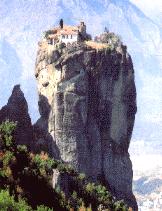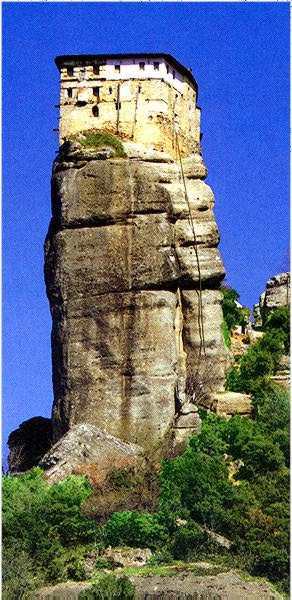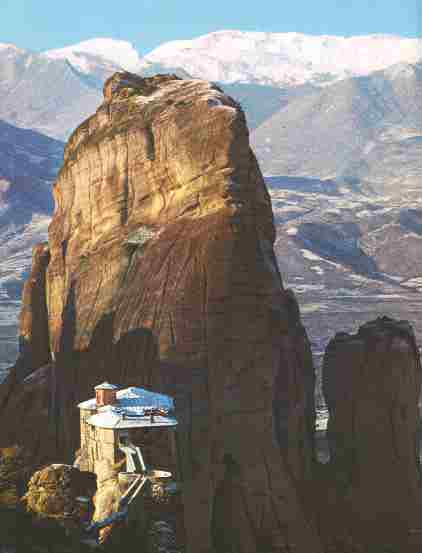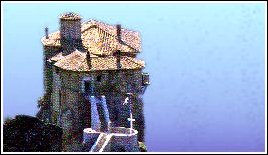|
|
Trikala
 Trikala, is west from Larissa,
near to Pinios river, the way to Kalambaka and Meteora. The
railway makes a similar number of connections between Larissa
and Trikala, though it loops around to the south through
Karditsa. A lively metropolis after the agricultural plains
towns of central Thessaly, Trikala retains many
nineteenth-century Turkish houses, and a graceful old mosque.
Around the Fortress, adapted by the Turks from a Byzantine
structure, are some attractive gardens and the meager remains
of a Sanctuary of Asklipious, the healing god whose cult is
said to have originated here. The liveliest part of town, with
numerous cafes and restaurants, is around Platia Iroon
Politechniou.
Trikala, is west from Larissa,
near to Pinios river, the way to Kalambaka and Meteora. The
railway makes a similar number of connections between Larissa
and Trikala, though it loops around to the south through
Karditsa. A lively metropolis after the agricultural plains
towns of central Thessaly, Trikala retains many
nineteenth-century Turkish houses, and a graceful old mosque.
Around the Fortress, adapted by the Turks from a Byzantine
structure, are some attractive gardens and the meager remains
of a Sanctuary of Asklipious, the healing god whose cult is
said to have originated here. The liveliest part of town, with
numerous cafes and restaurants, is around Platia Iroon
Politechniou.
Kalambaka:
The shabby town itself you hardly notice, for the eye is
immediately drawn up in an unremitting vertical ascent to the
weird gray cylinders of rock overhead, famed for its Byzantine
churches, is built where the river Pinios leaves the Pindus
mountains, at the foothills of Meteora.
Meteora: The
towns of Kalambaka (5.700 inhab.) and Kastraki (1,278
inhabits.) don't make it to many people's trip
destination lists simply because they are a little out of the
way. The
monasteries that adorn the top of the huge rocks that make
up "Ta Meteora" ("the things in the air")
are just unbelievable. The entire complex of monasteries has been designated as a
World
Heritage Site by UNESCO in 1988. Even the
surrounding area is very peaceful and unique, thanks to the
wildlife and wonderful rock formations.
 The Meteora monasteries rise at the center of Greece, where Pinios river
emerges from the deep canyons of the Pindus range and surges
into the Thessalian plain. These are gigantic rocks etched by
time into a variety of shapes; gray stalagmites rising towards
the sky, they appear as nature's gift to the pious who, driven
by faith, have opted for solitude and a life of worship. The
Monasteries, with their wooden galleries and corniced
rooftops, crown the summits of these formidable pinnacles.
Precariously hanging over the sinister abysses, with the
Pindus range at their back and the vast plain, woods, gorges
and picturesque villages below, these unworldly hermitages
compose one of the most breathtaking sites on earth.
The Meteora monasteries rise at the center of Greece, where Pinios river
emerges from the deep canyons of the Pindus range and surges
into the Thessalian plain. These are gigantic rocks etched by
time into a variety of shapes; gray stalagmites rising towards
the sky, they appear as nature's gift to the pious who, driven
by faith, have opted for solitude and a life of worship. The
Monasteries, with their wooden galleries and corniced
rooftops, crown the summits of these formidable pinnacles.
Precariously hanging over the sinister abysses, with the
Pindus range at their back and the vast plain, woods, gorges
and picturesque villages below, these unworldly hermitages
compose one of the most breathtaking sites on earth.
In the late Byzantine period and during Ottoman rule this monastic
community became a sanctuary of the persecuted. On these
barren and inaccessible rocks a center of Byzantine art was
created. The history of the Meteora monastic community begins
in the 11th century. During the 9th century hermits settled in
the caves and crevices of the rocks.
On Sundays and important
holidays they gathered in Doupiani, near Kastraki (where the
monastery and church of the Virgin Mary was later built), to
read mass. As monks increased, the cloisters of Doupiani and
Stagi were created. The development of the community, however,
may be more thoroughly traced from the 14th century onwards
when the first monasteries were established. Between 1356 and
1372 the monk Athanasius founded what was to become the most
important of all the Great Meteoron at Platis Lithos.
Athanasius imposed very strict rules on the community,
including the exclusion of women from the area. In 1388 John
Uresis, a disciple of Athanasius and a grandson of the Serbian
prince Stephen, retired to the monastery as monk Joasaph and
endowed it with many riches and special privileges. Soon the
Great Meteoron gained preponderance over all of the communes
and hermitages of the area. The development of the monasteries
as well led to the illustrious period of monastic life
particularly in the 15th and the 16th centuries. Gradually the
community began to deteriorate; of the twenty-four monasteries
that had been built throughout the years, only very few
continue to operate. In fact only five monasteries are still
inhabited today -the Great Meteoron, Agia Trias, Varlaam,
Agios Stefanos and Roussanou (the last two by nuns).
 A good paved road makes access to each of the main monasteries easy
and interesting. They may be visited in succession on a single
trip (21 km from Kalambaka and back). On the left of the road
to the monasteries, at the foot of the Meteora, stands
Doupiani hermitage and the 12th century chapel of the Virgin.
Nearby are the ruined monasteries of Pantocrator and Doupiani.
3 km from Kalambaka and again on our left is the monastery of
Agios Nikolaos Anapafsas. Built slightly before 1510 it was
decorated in 1527 with beautifully preserved frescoes by the
famous hagiographer Theophanes the Cretan. Close by are the
ruins of the monastery of Agia Moni, built around 1315. Six km
out, the road forks south and northwards. At the turning, on
our right we go by the Roussanou monastery, probably built in
1288 and renovated as a monastery in 1545. It contains
frescoes of the Cretan School, made in 1560. Following the
southern route, which will eventually take us to the monastery
of Agios Stephanos, we first come upon the Agia Trias
monastery, built between 1458 and 1476 by the monk Dometius.
Situated on a particularly beautiful pinnacle, it is reached
by a circular flight of stairs (approximately 140 steps). At
the end of the road is the nunnery and Museum of Agios
Stephanos. A steep gorge separates the pinnacle from the main
cliff; the two rocks are connected by a bridge. Referred to as
a hermitage at the beginning of the century, in 1333 Agios
Stephanos was visited by Emperor Andronicus the III
Paleologus. The head of the saint is preserved in the
monastery's cathedral Agios Haralambos. In the old church of
Agios Stephanos (1350) one can still admire the beautiful
gold-leaved wood carvings, wall paintings and old icons.
A good paved road makes access to each of the main monasteries easy
and interesting. They may be visited in succession on a single
trip (21 km from Kalambaka and back). On the left of the road
to the monasteries, at the foot of the Meteora, stands
Doupiani hermitage and the 12th century chapel of the Virgin.
Nearby are the ruined monasteries of Pantocrator and Doupiani.
3 km from Kalambaka and again on our left is the monastery of
Agios Nikolaos Anapafsas. Built slightly before 1510 it was
decorated in 1527 with beautifully preserved frescoes by the
famous hagiographer Theophanes the Cretan. Close by are the
ruins of the monastery of Agia Moni, built around 1315. Six km
out, the road forks south and northwards. At the turning, on
our right we go by the Roussanou monastery, probably built in
1288 and renovated as a monastery in 1545. It contains
frescoes of the Cretan School, made in 1560. Following the
southern route, which will eventually take us to the monastery
of Agios Stephanos, we first come upon the Agia Trias
monastery, built between 1458 and 1476 by the monk Dometius.
Situated on a particularly beautiful pinnacle, it is reached
by a circular flight of stairs (approximately 140 steps). At
the end of the road is the nunnery and Museum of Agios
Stephanos. A steep gorge separates the pinnacle from the main
cliff; the two rocks are connected by a bridge. Referred to as
a hermitage at the beginning of the century, in 1333 Agios
Stephanos was visited by Emperor Andronicus the III
Paleologus. The head of the saint is preserved in the
monastery's cathedral Agios Haralambos. In the old church of
Agios Stephanos (1350) one can still admire the beautiful
gold-leaved wood carvings, wall paintings and old icons.
Back to the crossroads and on the northern route one soon comes upon the
monastery of Varlaam by climbing 195 steps. It was built as
late as 1517 by the brothers Theophanes and Nectarios, scions
of a rich family from Janena, on the site of the old hermitage
of the hermit Varlaam. The frescoes in the chapel of All
Saints are by the famous hagiographer Franco Catellano, done
in 1548; the Narthex in 1566. The chapel of the Three
Hierarchs was renovated in 1627. The road stops at the Great
Meteoron, the biggest and the most important of the
monasteries. In older days ascent to the monastery was made by
jointed ladders and by nets of baskets. Today one goes up a
flight of 115 steep, irregular stairs cut into the rock face.
Thanks to lavish endowments the Great Meteoron became
autonomous and acquired many valuable works of art. One should
also visit the exquisite church of the Transfiguration with
fine frescoes, fascinating to the visitor, and an intricate
twelve - sided dome. Of interest too are the monastery's
Refectory - today a Museum - and its Library's numerous
manuscripts and rare books. When stopping at these isolated
monasteries and looking at the Pindus range and the Thessalian
plain down below, one understands why the hermits chose this
spot in order to serve God and approach him.
 The earliest
religious communities in the valley emerged in the eleventh
century, when hermits made their homes in the caves that score
many of the rocks. In 1336 they were joined by two monks from
Mount Αthos, one of whom – Athanassios – established
the first monastery here in 1389. Today, put firmly on the map
by appearances in such films as James Bond's For Your Eyes
Only, the four most accessible monasteries are essentially
museums. Only two, Agia Triada and Αgios Stefanos,
continue to function with any real monastic purpose. The earliest
religious communities in the valley emerged in the eleventh
century, when hermits made their homes in the caves that score
many of the rocks. In 1336 they were joined by two monks from
Mount Αthos, one of whom – Athanassios – established
the first monastery here in 1389. Today, put firmly on the map
by appearances in such films as James Bond's For Your Eyes
Only, the four most accessible monasteries are essentially
museums. Only two, Agia Triada and Αgios Stefanos,
continue to function with any real monastic purpose.
Kastraki, is twenty minutes walk out of Kalambaka. Along the way you pass
the busy Camping Vrachos, the first of two campsites here; the
other one, Boufiohis, is smaller but quieter and incomparably
set under the pinnacles. |